Do Satellite Data Correlate with In Situ Rainfall and Smallholder Crop Yields? Implications for Crop Insurance
Abstract
:1. Introduction
2. Materials and Methods
2.1. Study Area
2.2. Data
2.3. Data Analysis
2.3.1. Relationship between Satellite Data and In Situ Rainfall
2.3.2. Crop Yield Relationships with Rainfall and NDVI
3. Results
3.1. Correlations between Satellite and WS Data
3.2. Yield Estimation with Rainfall and NDVI
4. Discussions and Conclusions
4.1. Relationships between the Satellite and WS Data
4.2. Relationship of Yield with Rainfall and NDVI
Author Contributions
Funding
Institutional Review Board Statement
Informed Consent Statement
Data Availability Statement
Acknowledgments
Conflicts of Interest
References
- Carter, M.; De Janvry, A.; Sadoulet, E.; Sarris, A. Index-Based Weather Insurance for Developing Countries: A Review of Evidence and A Set of Propositions for Up-Scaling; FERDI: Clermont-Ferrand, France, 2014; Available online: https://ferdi.fr/dl/df-kLB5hYBaUiR2Vysm2cH5DfCP/ferdi-p111-index-based-weather-insurance-for-developing-countries-a-review.pdf (accessed on 18 January 2018).
- Masih, I.; Maskey, S.; Mussá, F.E.F.; Trambauer, P. A review of droughts on the African continent: A geospatial and long-term perspective. Hydrol. Earth Syst. Sci. 2014, 18, 3635–3649. [Google Scholar] [CrossRef] [Green Version]
- Gautier, D.; Denis, D.; Locatelli, B. Impacts of drought and responses of rural populations in West Africa: A systematic review. Wiley Interdiscip. Rev. Clim. Chang. 2016, 7, 666–681. [Google Scholar] [CrossRef]
- Manderson, A.; Kubayi, N.; Drimie, S. The Impact of the South Africa Drought As Experienced by Smallholder Farmers over June 2015–February 2016 Period in the Mopani District of Limpopo, South Africa. Stellenbosch: Agro-ecology Awareness Project, South African Food Lab 2016. Available online: http://www.southernafricafoodlab.org/wp-content/uploads/2016/06/SAFL-Drough-Impact-Assessment-2016-Final.pdf (accessed on 10 May 2019).
- Gebremeskel, G.; Tang, Q.; Sun, S.; Huang, Z.; Zhang, X.; Liu, X. Droughts in East Africa: Causes, impacts and resilience. Earth Sci. Rev. 2019, 193, 146–161. [Google Scholar] [CrossRef]
- Nembilwi, N.; Chikoore, H.; Kori, E.; Munyai, R.B.; Manyanya, T.C. The occurrence of drought in Mopani District Municipality, South Africa: Impacts, vulnerability and adaptation. Climate 2021, 9, 61. [Google Scholar] [CrossRef]
- Kahan, D. (Ed.) Farm Management Extension Guide: Managing Risks in Farming, 2013th ed.; FAO: Rome, Italy, 2013; Volume 6, ISBN 978-92-5-107544-9. Available online: http://www.fao.org/uploads/media/3-ManagingRiskInternLores.pdf (accessed on 14 July 2020).
- Hansen, J.; Hellin, J.; Rosenstock, T.; Fisher, E.; Cairns, J.; Stirling, C.; Lamanna, C.; van Etten, J.; Rose, A.; Campbell, B. Climate risk management and rural poverty reduction. Agric. Syst. 2019, 172, 28–46. [Google Scholar] [CrossRef]
- Komarek, A.M.; De Pinto, A.; Smith, V.H. A review of types of risks in agriculture: What we know and what we need to know. Agric. Syst. 2020, 178, 102738. [Google Scholar] [CrossRef]
- Tadesse, M.A.; Shiferaw, B.A.; Erenstein, O. Weather index insurance for managing drought risk in smallholder agriculture: Lessons and policy implications for sub-Saharan Africa. Agric. Food Econ. 2015, 3, 1–21. [Google Scholar] [CrossRef] [Green Version]
- Bucheli, J.; Dalhaus, T.; Finger, R. The optimal drought index for designing weather index insurance. Eur. Rev. Agric. Econ. 2021, 48, 573–597. [Google Scholar] [CrossRef]
- IFAD. Remote Sensing for Index Insurance; International Fund of Agricultural Development (IFAD): Rome, Italy, 2015; ISBN 9789290725619. Available online: https://www.ifad.org/en/web/knowledge/publication/asset/39552352 (accessed on 12 March 2018).
- ACRE-AFRICA. A Data Driven Approach to Integrated Risk Management in Agriculture Food Shock Modelling; ACRE-AFRICA: Nairobi, Kenya, 2019. [Google Scholar]
- Choudhury, A.; Jones, J.; Okine, A.; Choudhury, R.L. Drought-triggered index insurance using cluster analysis of rainfall affected by climate change. J. Insur. Issues 2016, 39, 169–186. [Google Scholar]
- Carter, M.; De Janvry, A.; Sadoulet, E.; Sarris, A. Index insurance for developing country agriculture: A reassessment. Annu. Rev. Resour. Econ. 2017, 9, 421–438. [Google Scholar] [CrossRef]
- World Bank. Weather Index Insurance for Agriculture: Guidance for Development Practitioners; World Bank: Washington, DC, USA, 2011; Available online: https://documents1.worldbank.org/curated/en/590721468155130451/pdf/662740NWP0Box30or0Ag020110final0web.pdf (accessed on 28 April 2019).
- He, J.; Zheng, X.; Rejesus, R.M.; Yorobe, J.M., Jr. Moral hazard and adverse selection effects of cost-of-production crop insurance: Evidence from the Philippines. Aust. J. Agric. Resour. Econ. 2019, 63, 166–197. [Google Scholar] [CrossRef] [Green Version]
- Clement, K.Y.; Wouter Botzen, W.J.; Brouwer, R.; Aerts, J.C.J.H. A global review of the impact of basis risk on the functioning of and demand for index insurance. Int. J. Disaster Risk Reduct. 2018, 28, 845–853. [Google Scholar] [CrossRef]
- Dalhaus, T.; Musshoff, O.; Finger, R. Phenology information contributes to reduce temporal basis risk in agricultural weather index insurance. Sci. Rep. 2018, 8, 1–10. [Google Scholar] [CrossRef] [PubMed]
- Ritter, M.; Mußhoff, O.; Odening, M. Minimizing geographical basis using a multi-site rainfall model. Comput. Econ. 2014, 44, 67–86. [Google Scholar] [CrossRef] [Green Version]
- Boyd, M.; Porth, B.; Porth, L.; Turenne, D. The impact of spatial interpolation techniques on spatial basis risk for weather insurance: An application to forage crops. N. Am. Actuar. J. 2019, 23, 412–433. [Google Scholar] [CrossRef] [Green Version]
- Kölle, W.; Buchholz, M.; Musshoff, O. Do high-resolution satellite indices at field level reduce basis risk of satellite-based weather index insurance? Agric. Financ. Rev. 2021. ahead-of-print. [Google Scholar] [CrossRef]
- Chen, W.; Hohl, R.; Tiong, L.K. Rainfall index insurance for corn farmers in Shandong based on high-resolution weather and yield data. Agric. Financ. Rev. 2017, 77, 337–354. [Google Scholar] [CrossRef]
- Anghileri, D.; Bozzini, V.; Molnar, P.; Sheffield, J. Comparison of hydrological and vegetation remote sensing datasets as proxies for rainfed maize yield in Malawi. Agric. Water Manag. 2021, 262, 107375. [Google Scholar] [CrossRef]
- Dalhaus, T.; Finger, R. Can gridded precipitation data and phenological observations reduce basis risk of weather index—based insurance? Weather. Clim. Soc. 2016, 8, 409–419. [Google Scholar] [CrossRef]
- Black, E.; Tarnavsky, E.; Maidment, R.; Greatrex, H.; Mookerjee, A.; Quaife, T.; Brown, M. The use of remotely sensed rainfall for managing drought risk: A case study of weather index insurance in Zambia. Remote Sens. 2016, 8, 342. [Google Scholar] [CrossRef] [Green Version]
- Valverde-Arias, O.; Garrido, A.; Saa-Requejo, A.; Carreño, F.; Tarquis, A.M. Agro-ecological variability effects on an index-based insurance design for extreme events. Geoderma 2019, 337, 1341–1350. [Google Scholar] [CrossRef]
- Enenkel, M.; Farah, C.; Hain, C.; White, A.; Anderson, M.; You, L.; Wagner, W.; Osgood, D. What rainfall does not tell us—enhancing financial instruments with satellite-derived soil moisture and evaporative stress. Remote Sens. 2018, 10, 1819. [Google Scholar] [CrossRef] [Green Version]
- Enenkel, M.; Osgood, D.; Anderson, M.; Powell, B.; McCarty, J.; Neigh, C.; Carroll, M.; Wooten, M.; Husak, G.; Hain, C.; et al. Exploiting the convergence of evidence in satellite data for advanced weather index insurance design. Weather. Clim. Soc. 2019, 11, 65–93. [Google Scholar] [CrossRef]
- Hochrainer-Stigler, S.; van der Velde, M.; Fritz, S.; Pflug, G. Remote sensing data for managing climate risks: Index-based insurance and growth related applications for smallhold-farmers in Ethiopia. Clim. Risk Manag. 2014, 6, 27–38. [Google Scholar] [CrossRef] [Green Version]
- Eze, E.; Girma, A.; Zenebe, A.A.; Zenebe, G. Feasible crop insurance indexes for drought risk management in Northern Ethiopia. Int. J. Disaster Risk Reduct. 2020, 47, 101544. [Google Scholar] [CrossRef]
- Masiza, W.; Chirima, J.G.; Hamandawana, H.; Kalumba, A.M.; Magagula, H.B. Linking Agricultural Index Insurance with Factors That Influence Maize Yield in Rain-Fed Smallholder Farming Systems. Sustainability 2021, 13, 5176. [Google Scholar] [CrossRef]
- Banerjee, H.; Goswami, R.; Chakraborty, S.; Dutta, S.; Majumdar, K.; Satyanarayana, T.; Jat, M.L.; Zingore, S. Understanding biophysical and socio-economic determinants of maize (Zea mays L.) yield variability in eastern India. NJAS Wagening J. Life Sci. 2014, 70, 79–93. [Google Scholar] [CrossRef] [Green Version]
- Dutta, S.; Chakraborty, S.; Goswami, R.; Banerjee, H.; Majumdar, K.; Li, B.; Jat, M.L. Maize yield in smallholder agriculture system—An approach integrating socio-economic and crop management factors. PLoS ONE 2020, 15, e0229100. [Google Scholar] [CrossRef]
- Tamene, L.; Mponela, P.; Ndengu, G.; Kihara, J. Assessment of maize yield gap and major determinant factors between smallholder farmers in the Dedza district of Malawi. Nutr. Cycl. Agroecosyst. 2016, 105, 291–308. [Google Scholar] [CrossRef]
- Djurfeldt, G.; Hall, O.; Jirström, M.; Archila Bustos, M.; Holmquist, B.; Nasrin, S. Using panel survey and remote sensing data to explain yield gaps for maize in sub-Saharan Africa. J. Land Use Sci. 2018, 13, 344–357. [Google Scholar] [CrossRef] [Green Version]
- Chivasa, W.; Mutanga, O.; Biradar, C. Application of remote sensing in estimating maize grain yield in heterogeneous African agricultural landscapes: A review. Int. J. Remote Sens. 2017, 38, 6816–6845. [Google Scholar] [CrossRef]
- FAO. Crop Yield Forecasting: Methodological and Institutional Aspects; FAO: Rome, Italy, 2016. Available online: www.fao.org/publications (accessed on 12 February 2018).
- Carletto, C.; Jolliffe, D.; Banerjee, R. The Emperor Has No Data! Agricultural Statistics in Sub-Saharan Africa; World Bank: Washington, DC, USA, 2013; Available online: http://mortenjerven.com/wp-content/uploads/2013/04/Panel-3-Carletto.pdf (accessed on 16 March 2018).
- Lobell, D.B.; Di Tommaso, S.; You, C.; Djima, I.Y.; Burke, M.; Kilic, T. Sight for sorghums: Comparisons of satellite-and ground-based sorghum yield estimates in Mali. Remote Sens. 2020, 12, 100. [Google Scholar] [CrossRef] [Green Version]
- Paliwal, A.; Jain, M. The accuracy of self-reported crop yield estimates and their ability to train remote sensing algorithms. Front. Sustain. Food Syst. 2020, 4, 1–10. [Google Scholar] [CrossRef] [Green Version]
- Greenberg, S.; Swanepoel, S.; Lewis, L. Input Supply in South Africa’s Smallholder Farmer Support Programmes: A Tale of Neo-Apartheid Plans, Dodgy Dealings and Corporate Capture; African Centre for Biodiversity: Johannesburg, South Africa, 2018. [Google Scholar]
- Gourlay, S.; Kilic, T.; Lobell, D. Could the Debate Be Over? Errors in Farmer-Reported Production and Their Implications for the Inverse Scale-Productivity Relationship in Uganda; World Bank: Washington, DC, USA, 2017. [Google Scholar]
- Le Coz, C.; Van De Giesen, N. Comparison of rainfall products over sub-saharan africa. J. Hydrometeorol. 2020, 21, 553–596. [Google Scholar] [CrossRef]
- DALRRD. Trends in the Agricultural Sector; DALRRD: Pretoria, South Africa, 2018. Available online: https://www.dalrrd.gov.za/Portals/0/Statistics%20and%20Economic%20Analysis/Statistical%20Information/Trends%20in%20the%20Agricultural%20Sector%202017.pdf (accessed on 15 November 2018).
- Beck, H.E.; Zimmermann, N.E.; McVicar, T.R.; Vergopolan, N.; Berg, A.; Wood, E.F. Present and future köppen-geiger climate classification maps at 1-km resolution. Sci. Data 2018, 5, 180214. [Google Scholar] [CrossRef] [Green Version]
- Jordaan, A.; Makate, D.; Mashego, T.; Ligthelm, M.; Malherbe, J.; Mwaka, B.; Olivier, W.; Symington, W.; Zyl, V. Vulnerability, Adaptation to and Coping with Drought: The Case of Commercial and Subsistence Rain Fed Farming in the Eastern Cape; Water Research Commission: Pretoria, South Africa, 2017; Volume I, ISBN 9781431208852. Available online: www.wrc.org.za (accessed on 6 June 2018).
- Eta, N.E.; Grace, G. Investigation of some physicochemical charactyeristics/prperties of geophagic soil in the Oliver Tambo District Munucipality in the Eastern cape. Acad. J. Sci. 2013, 2, 465–471. [Google Scholar]
- Sibanda, M.; Mushunje, A.; Mutengwa, C.S. An evaluation on the profitability of growing improved maize open pollinated varieties in the Eastern Cape Province, South Africa. J. Dev. Agric. Econ. 2016, 8, 1–13. [Google Scholar] [CrossRef] [Green Version]
- Funk, C.; Peterson, P.; Landsfeld, M.; Pedreros, D.; Verdin, J.; Shukla, S.; Husak, G.; Rowland, J.; Harrison, L.; Hoell, A.; et al. The climate hazards infrared precipitation with stations—A new environmental record for monitoring extremes. Sci. Data 2015, 2, 150066. [Google Scholar] [CrossRef] [Green Version]
- Didan, K.; Munoz, A.B.; Solano, R.; Huete, A. MODIS vegetation index user ’s guide. Univ. Ariz. Veg. Index Phenol. Lab 2015, 2015, 1–38. [Google Scholar]
- Huete, A.; Didan, K.; van Leeuwen, W.; Miura, T.; Glenn, E. MODIS Vegetation Indices. In Land Remote Sensing and Global Environmental Change; Ramachandran, B., Justice, C., Abrams, M., Eds.; Springer: Berlin, Germany, 2010; pp. 579–602. [Google Scholar] [CrossRef]
- Drusch, M.; Del Bello, U.; Carlier, S.; Colin, O.; Fernandez, V.; Gascon, F.; Hoersch, B.; Isola, C.; Laberinti, P.; Martimort, P.; et al. Sentinel-2: ESA’s optical high-resolution mission for GMES operational services. Remote Sens. Environ. 2012, 120, 25–36. [Google Scholar] [CrossRef]
- Tarnavsky, E.; Grimes, D.; Maidment, R.; Black, E.; Allan, R.P.; Stringer, M.; Chadwick, R.; Kayitakire, F. Extension of the TAMSAT satellite-based rainfall monitoring over Africa and from 1983 to present. J. Appl. Meteorol. Climatol. 2014, 53, 2805–2822. [Google Scholar] [CrossRef] [Green Version]
- Dinku, T.; Funk, C.; Peterson, P.; Maidment, R.; Tadesse, T.; Gadain, H.; Ceccato, P. Validation of the CHIRPS satellite rainfall estimates over eastern Africa. Q. J. R. Meteorol. Soc. 2018, 144, 292–312. [Google Scholar] [CrossRef] [Green Version]
- Caroletti, G.N.; Coscarelli, R.; Caloiero, T. Validation of satellite, reanalysis and RCM data of monthly rainfall in Calabria (Southern Italy). Remote Sens. 2019, 11, 1625. [Google Scholar] [CrossRef] [Green Version]
- Makaudze, E.M.; Miranda, M.J. Catastrophic drought insurance based on the remotely sensed normalised difference vegetation index for smallholder farmers in Zimbabwe. Agrekon 2010, 49, 418–432. [Google Scholar] [CrossRef]
- Enenkel, M.; Osgood, D.; Powell, B. The added value of satellite soil moisture for agricultural index insurance. In Remote Sensing of Hydrometeorological Hazards; Petropoulos, G.P., Islam, T., Eds.; CRS Press: Boca Raton, FL, USA, 2017; pp. 69–83. ISBN 9781315154947. [Google Scholar]
- USDA. Commodity Intelligence Report; USDA: Washington, DC, USA, 2018. Available online: https://ipad.fas.usda.gov/highlights/2012/08/Mexico_corn/ (accessed on 13 June 2020).
- Greyling, J.C.; Pardey, P.G. Measuring maize in South Africa: The shifting structure of production during the twentieth century, 1904–2015. Agrekon 2019, 58, 21–41. [Google Scholar] [CrossRef]
- Haarhoff, S.J.; Kotzé, T.N.; Swanepoel, P.A. A prospectus for sustainability of rainfed maize production systems in South Africa. Crop Sci. 2020, 60, 14–28. [Google Scholar] [CrossRef] [Green Version]
- Chimonyo, V.G.P.; Mutengwa, C.; Chiduza, C.; Tandzi, L. Characteristics of maize growing farmers, varietal use, and constraints to increase productivity in selected villages in the Eastern Cape province of South Africa. S. Afr. J. Agric. Ext. 2020, 48, 71–77. [Google Scholar] [CrossRef]
- Kambanje, A.; Taruvinga, A.; Mushunje, A.; Mutengwa, C.; Ngarava, S. Determinants of food security status amongst smallholder farmers utilizing. J. Soc. Sci. Res. 2020, 6, 133–139. [Google Scholar]
- Frost, C.; Thiebaut, N.; Newby, T. Evaluating Terra MODIS satellite sensor data products for maize yield estimation in South Africa. S. Afr. J. Geomat. 2013, 2, 106–119. [Google Scholar]
- Mditshwa, S. Estimating Maize Grain Yield from Crop Growth Stages Using Remote Sensing and GIS in the Free State Province, South Africa, Univesrity of Fort Hare. 2017. Available online: http://vital.seals.ac.za:8080/vital/access/manager/Repository/vital:29481?site_name=GlobalView&view=null&f0=sm_format%3A%2284+leaves%22&f1=sm_creator%3A%22Mditshwa%2C+Sithembele%22&sort=null (accessed on 28 January 2022).
- Ngie, A.; Ahmed, F. Estimation of Maize grain yield using multispectral satellite data sets (SPOT 5) and the random forest algorithm. S. Afr. J. Geomat. 2018, 7, 11. [Google Scholar] [CrossRef] [Green Version]
- Epule, T.E.; Ford, J.D.; Lwasa, S.; Nabaasa, B.; Buyinza, A. The determinants of crop yields in Uganda: What is the role of climatic and non-climatic factors? Agric. Food Secur. 2018, 7, 1–17. [Google Scholar] [CrossRef]
- Mujuru, N.M.; Obi, A. Effects of cultivated area on smallholder farm profits and food security in rural communities of the Eastern Cape province of South Africa. Sustainability 2020, 12, 3272. [Google Scholar] [CrossRef] [Green Version]
- World Bank. Agricultural Data and Insurance; World Bank: Washington DC, USA, 2015; Available online: https://blogs.worldbank.org/sites/default/files/agricultural-insurance-data-15sept2015.pdf (accessed on 2 January 2022).
- Hernandez, E.; Goslinga, R.; Wang, V. Using Satellite Data to Scale Smallholder Agricultural Insurance; CGAP: Washington, DC, USA, 2018. [Google Scholar]
- Iortyom, E.T.; Mazinyo, S.P.; Nel, W. Analysis of the economic impact of Rural Enterprise Development Hub Project on maize farmers in Mqanduli, South Africa. Indian J. Agric. Res. 2018, 52, 243–249. [Google Scholar] [CrossRef] [Green Version]
- Smith, M.; Kivumbi, D.; Heng, L. Use of the FAO CROPWAT Model in Deficit Irrigation Studies; FAO: Rome, Italy, 2002; pp. 17–27. Available online: https://agris.fao.org/agris-search/search.do?recordID=XF2002407869 (accessed on 6 February 2019).
- Muhammad, N. Simulation of maize crop under irrigated and rainfed conditions with CROPWAT model. J. Agric. Biol. Sci. 2009, 4, 68–73. [Google Scholar]
- Kumar, A.A.; Akula, B.; Mani, A. Estimation of water requirement in maize using CROPWAT model. J. Pharmacogn. Phytochem. 2019, 8, 2533–2537. [Google Scholar]
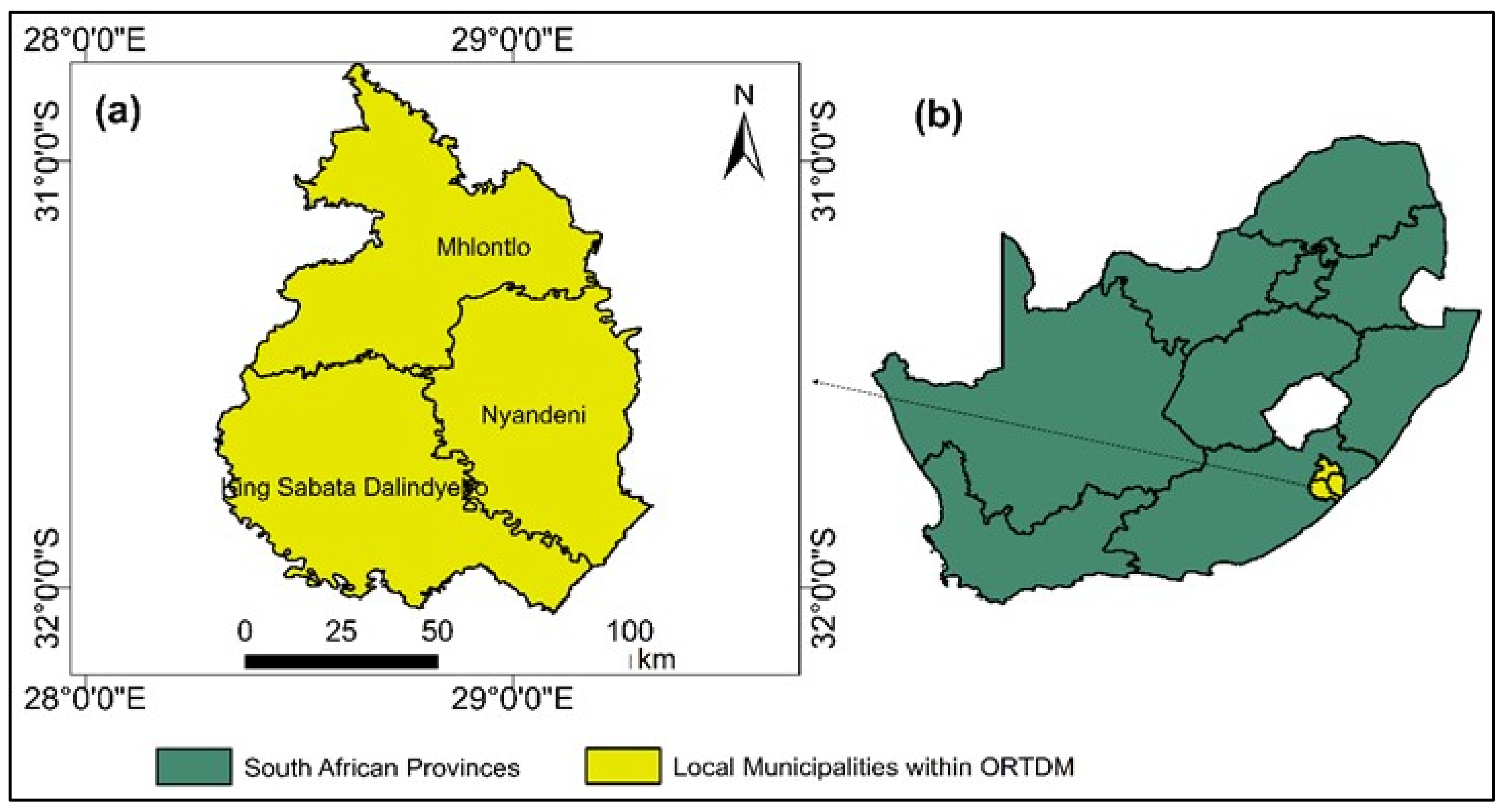
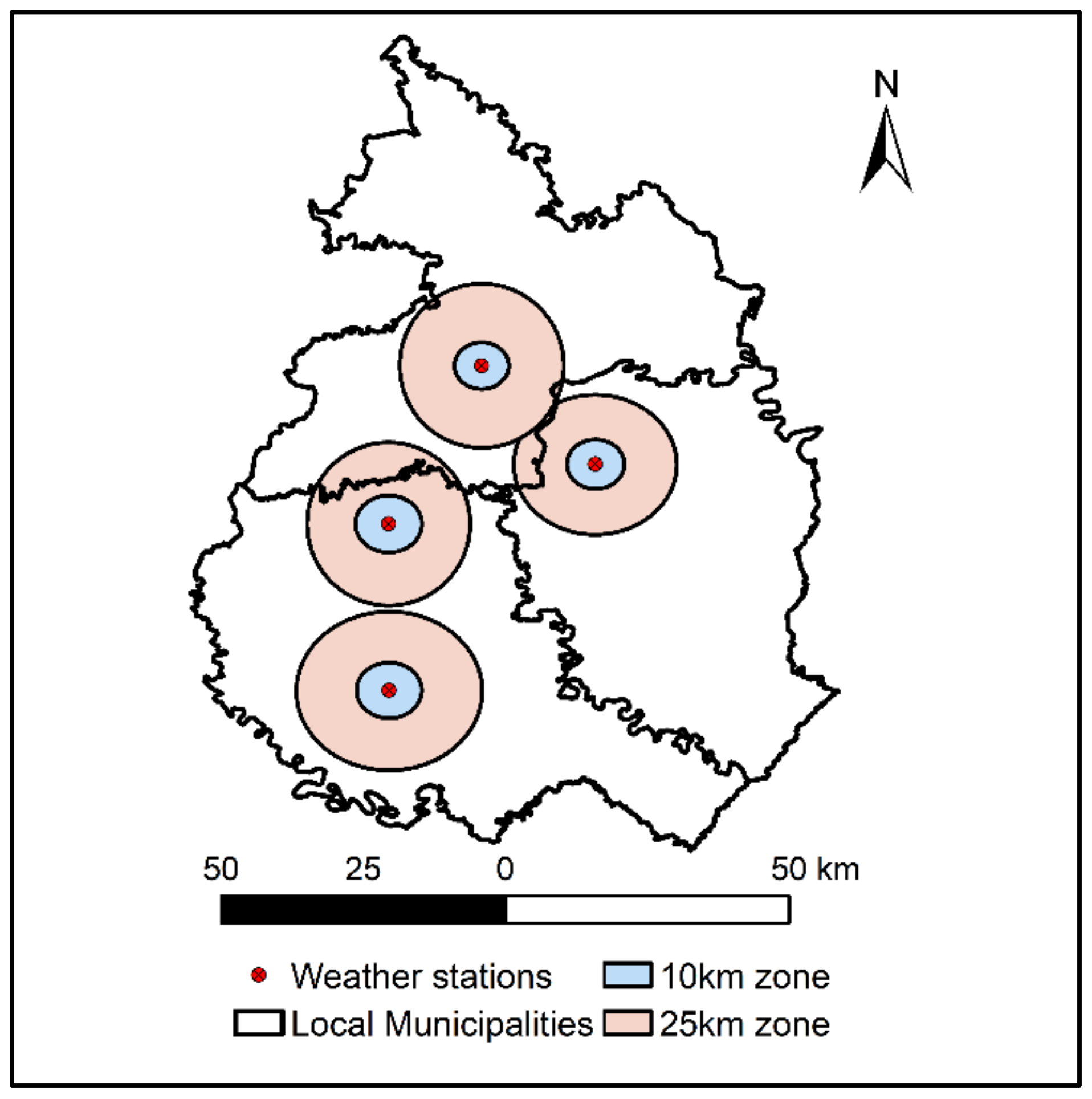
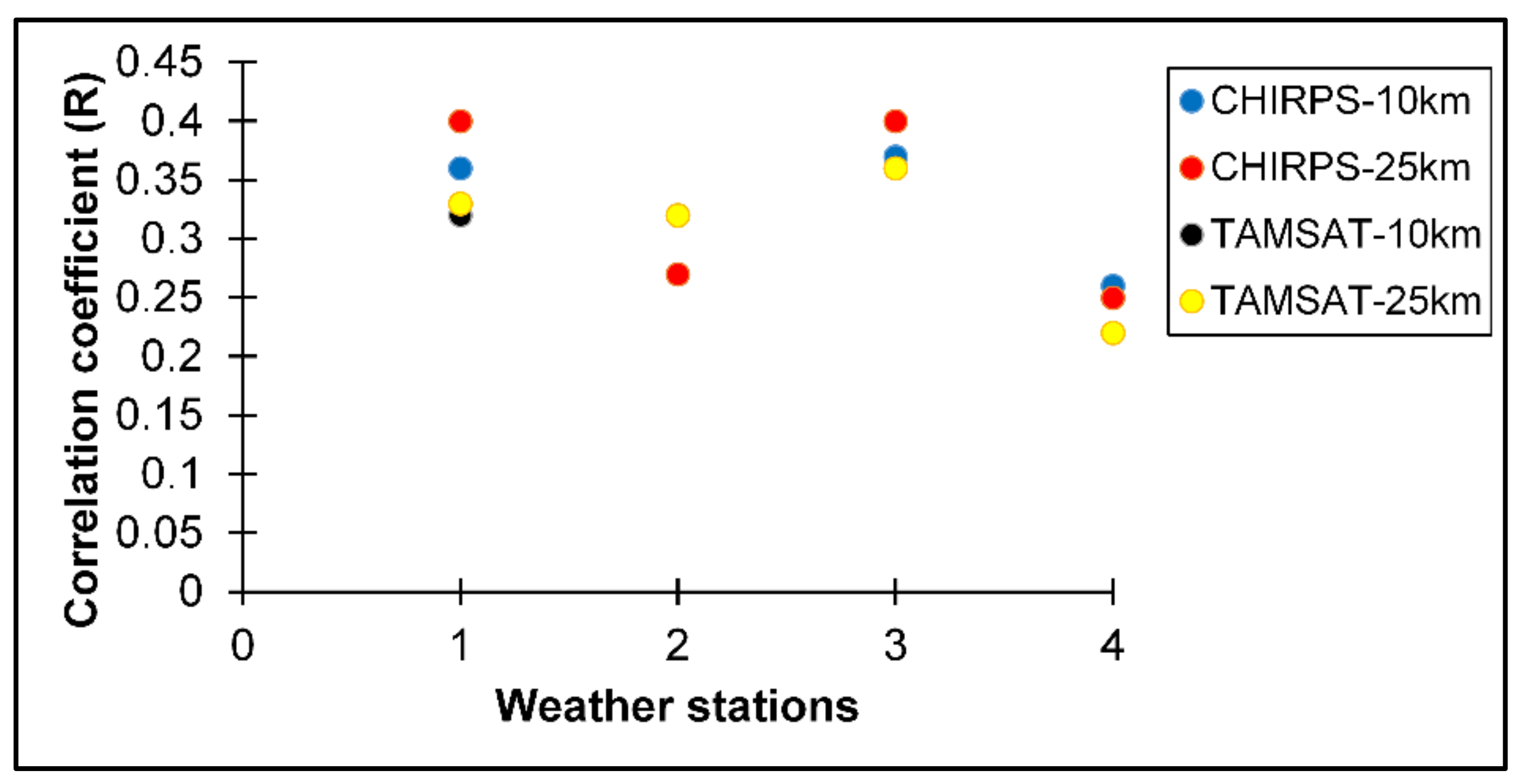

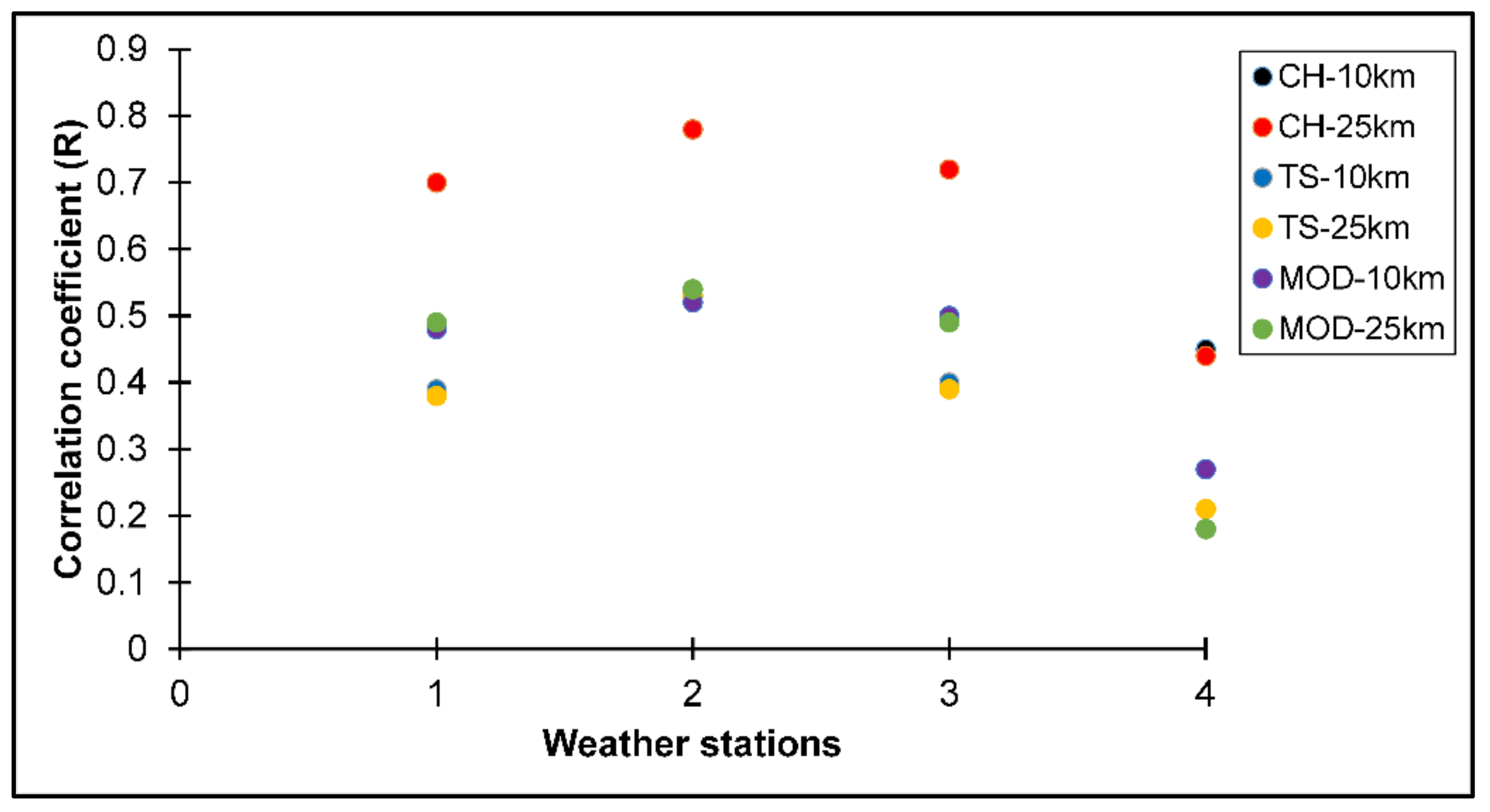
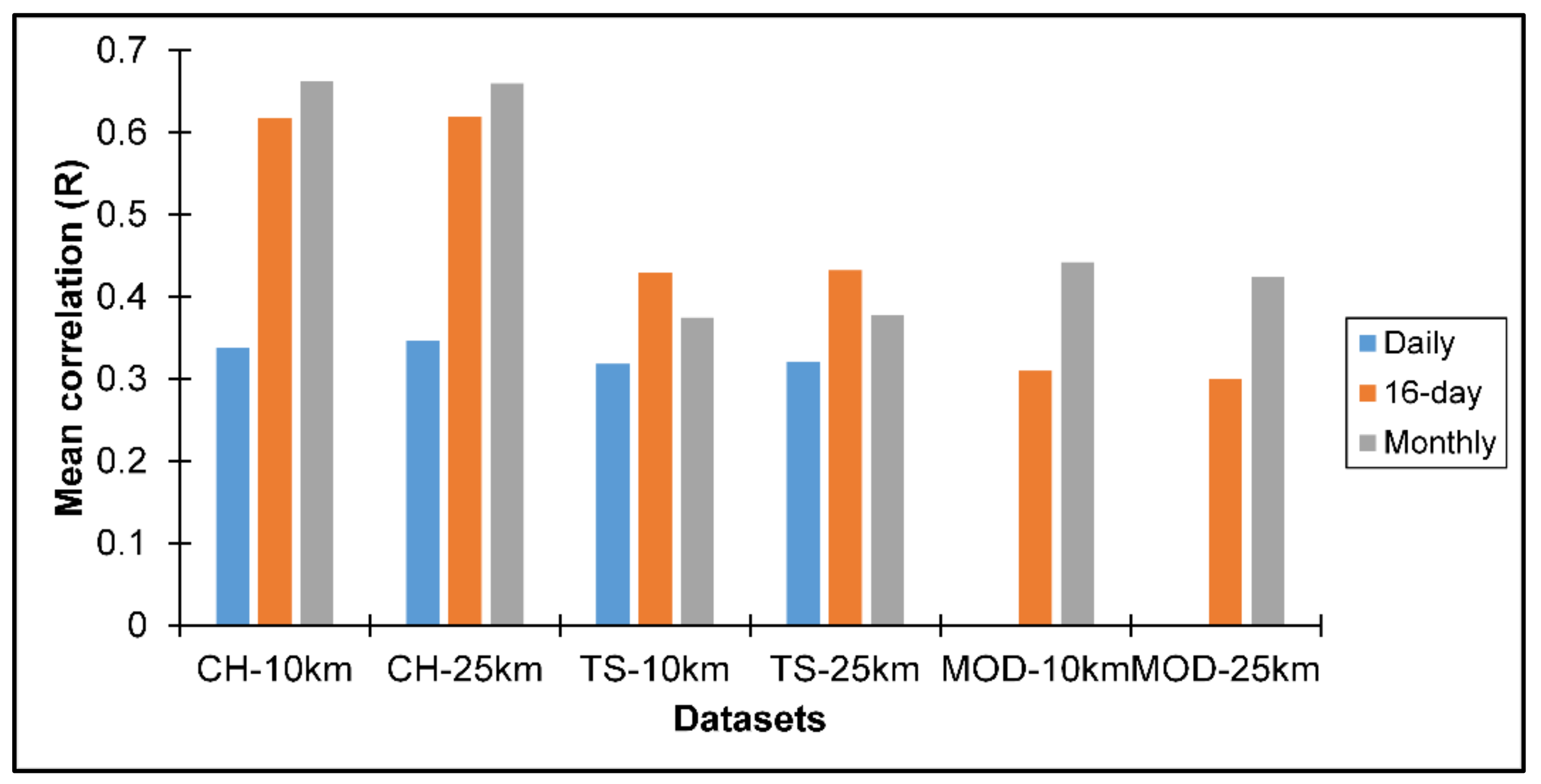
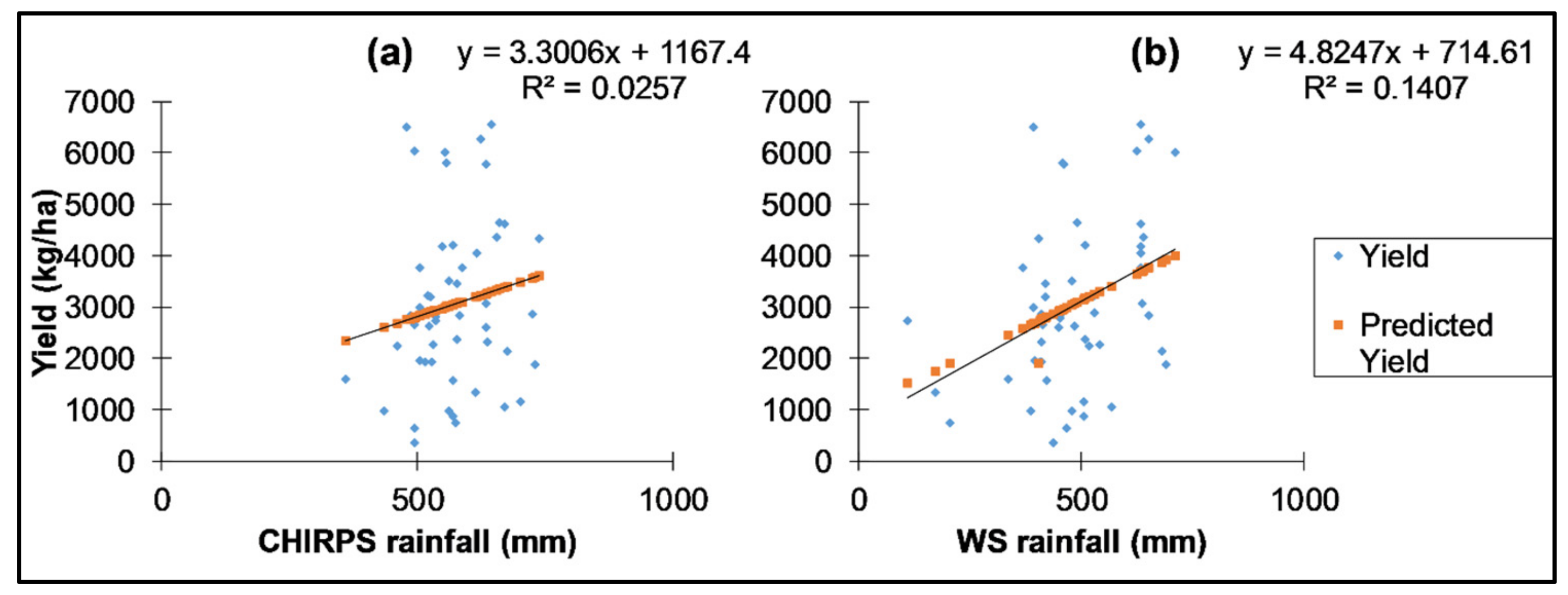

Publisher’s Note: MDPI stays neutral with regard to jurisdictional claims in published maps and institutional affiliations. |
© 2022 by the authors. Licensee MDPI, Basel, Switzerland. This article is an open access article distributed under the terms and conditions of the Creative Commons Attribution (CC BY) license (https://creativecommons.org/licenses/by/4.0/).
Share and Cite
Masiza, W.; Chirima, J.G.; Hamandawana, H.; Kalumba, A.M.; Magagula, H.B. Do Satellite Data Correlate with In Situ Rainfall and Smallholder Crop Yields? Implications for Crop Insurance. Sustainability 2022, 14, 1670. https://doi.org/10.3390/su14031670
Masiza W, Chirima JG, Hamandawana H, Kalumba AM, Magagula HB. Do Satellite Data Correlate with In Situ Rainfall and Smallholder Crop Yields? Implications for Crop Insurance. Sustainability. 2022; 14(3):1670. https://doi.org/10.3390/su14031670
Chicago/Turabian StyleMasiza, Wonga, Johannes George Chirima, Hamisai Hamandawana, Ahmed Mukalazi Kalumba, and Hezekiel Bheki Magagula. 2022. "Do Satellite Data Correlate with In Situ Rainfall and Smallholder Crop Yields? Implications for Crop Insurance" Sustainability 14, no. 3: 1670. https://doi.org/10.3390/su14031670
APA StyleMasiza, W., Chirima, J. G., Hamandawana, H., Kalumba, A. M., & Magagula, H. B. (2022). Do Satellite Data Correlate with In Situ Rainfall and Smallholder Crop Yields? Implications for Crop Insurance. Sustainability, 14(3), 1670. https://doi.org/10.3390/su14031670






